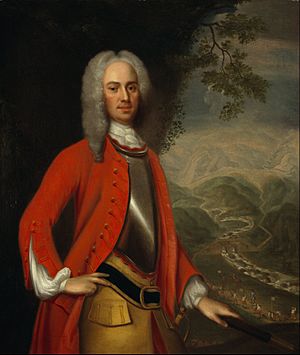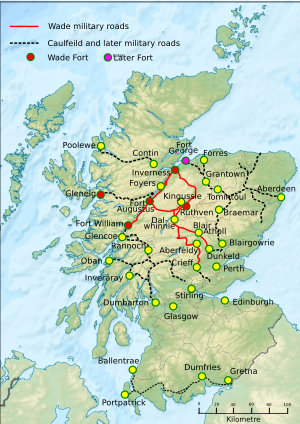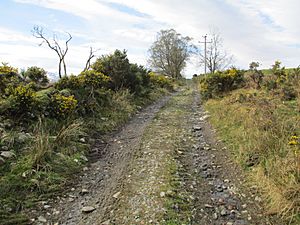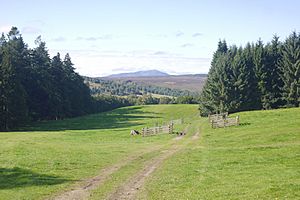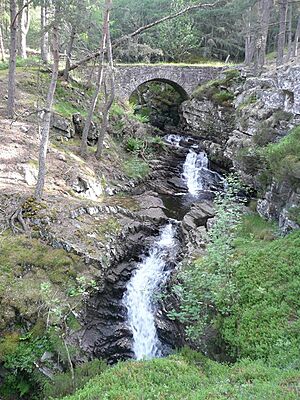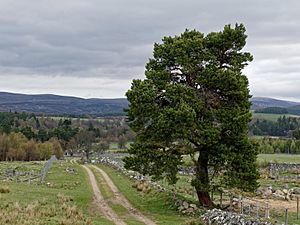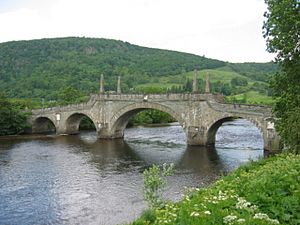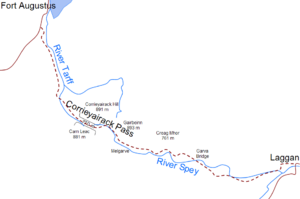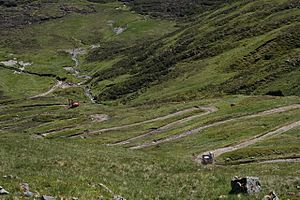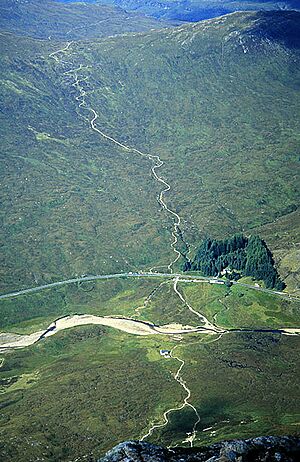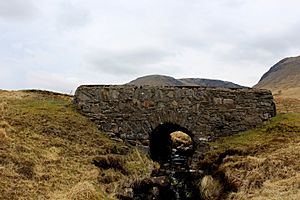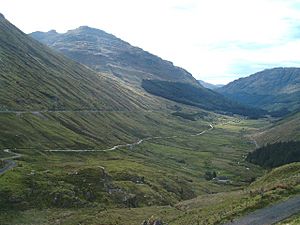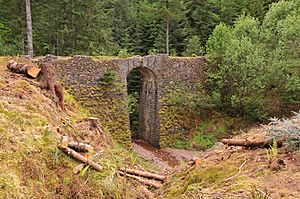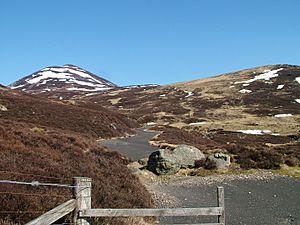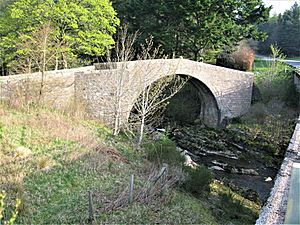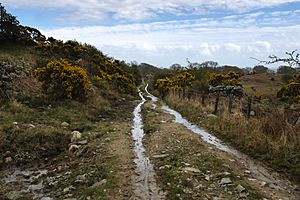Military roads of Scotland facts for kids
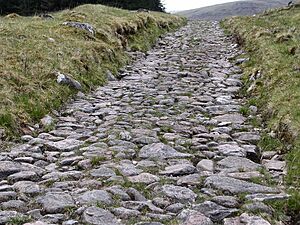
Military roads, sometimes called General Wade's Military Roads, were built in the Scottish Highlands in the 1700s. The British Government built them to bring order to the country. This was after the Jacobite rebellion of 1715.
These roads connected the Central Lowlands with strong barracks across the Highlands. Their main goal was to control the local people. This was similar to how the Romans built roads over 1,500 years earlier. Roman roads did not reach the Highlands, which is where these new roads were built.
The first four roads were built between 1720 and 1730. General George Wade led this work. That is why they are often called General Wade’s Military Roads, or just Wade’s Roads.
Later, Major William Caulfeild greatly expanded the road network. However, his name is mostly forgotten. Today, maps often just call his roads "Old Military Road." Caulfeild also built another road in southwest Scotland in the 1760s.
General Wade's Roads
General George Wade arrived in Scotland in July 1724. By December, he reported that many people in the Highlands were ready to rebel again. They wanted to support the Pretender. Wade said that government troops needed better roads and river crossings. This would help them stop any future rebellions.
King George I made Wade the Commander-in-chief in North Britain. Wade began building the first of his four roads the next year.
- From Inverness to Fort William (along the south side of Loch Ness).
- From Dunkeld to Inverness through the Pass of Drumochter.
- From Crieff to the existing road at Dalnacardoch. This route went through Aberfeldy and Tummel Bridge.
- From Dalwhinnie to Fort Augustus via Corrieyairack Pass. It also had a small branch to Ruthven.
The military built these roads. They cost about £90 per mile. The roads were usually 16 feet wide. But they could shrink to 10 feet wide if needed. Construction happened between April/May and October each year. Winters were too harsh for building. Summer work was also tough due to bad weather and many midges.
Building teams had 100 men. They were led by corporals, sergeants, and a captain. They often had a drummer too. Wade hired skilled workers like masons and carpenters. This made sure that big structures like bridges were built well. Camps were set up every 10 miles. Inns grew around these camps and were called Kingshouses. Some of these inns still serve travelers today. The famous Kingshouse on Rannoch Moor is near a route built by Wade's successor, William Caulfeild.
Fort William to Inverness Road
The British government built three forts along the Great Glen in the early 1700s. Fort William was at the southwest end. Fort Augustus was built in 1715 at the south end of Loch Ness. The first Fort George was in Inverness. After it was destroyed in 1746, a new one was built at Ardersier Point.
Wade built a road from sea to sea in 1726 and 1727. It linked these three forts. Before the northern part was finished, a boat carried people on Loch Ness. This boat stopped once the road was ready.
The southern part of the road goes east from Fort Augustus. It follows a path similar to the modern B862 road. It crosses the Allt Doe and passes Loch Tarff. Then it enters Stratherrick and goes along the western shore of Loch Mhòr. Minor roads today follow Wade's route northeast of Loch Duntelchaig.
A new northern section was built closer to Loch Ness in 1732. The modern B852 road follows this route between Inverness and Foyers. It joins the older road near Whitebridge.
Dunkeld to Inverness Road
Wade built this road between 1728 and 1730. In July 1728, Wade reported that about 300 men were working on it. Fifteen miles of the road were already finished.
The route started west from Dunkeld. It went through King's Pass and then north up the east side of Strathtay. It continued north through Ballinluig to Pitlochry. Then it went through the Pass of Killiecrankie into Glen Garry. It crossed the River Tilt at the Old Bridge of Tilt, north of Blair Atholl.
Some parts of the route are still there. They go past Dalnacardoch to the Pass of Drumochter and Dalwhinnie. Other parts are gone due to the modern A9 road. From Glen Truim, the route went east of the modern road. It passed through Glen Fernisdale and Phones. It crossed the Milton Burn at Drochaid Tigh na Mile (now a ford). Then it reached the barracks at Ruthven near Kingussie.
After crossing the River Spey, the road went along the west side of Strathspey. It passed through Kincraig, Alvie, and Aviemore to Kinveachy. From there, it went northwest, away from modern roads. It crossed the River Dulnain using the high stone arch of Sluggan Bridge. This bridge is now part of the National Cycle Network.
Wade built the road through the pass at The Slochd, just like the modern road. He crossed the River Findhorn at Raigbeg. He chose to cross the River Nairn at Bridge of Faillie. The road then ran a few more miles over Drummossie Muir to the barracks at Fort George, Inverness.
Crieff to Dalnacardoch Road
Wade built this road in 1730. The bridge over the River Tay at Aberfeldy was the most expensive part. It was designed by William Adam. It cost over £4000 when finished in 1734. This was several years after the rest of the road.
The route starts northeast from Crieff, crossing Crieff Golf Club. It turns north at Gilmerton towards the Sma' Glen. The A822 road follows a similar path, but they only meet in small sections. It crosses the River Almond at Newton Bridge. Then it goes north to Amulree where it crosses the River Braan.
The route first goes west of the modern A826 road through Glen Cochill. It then joins and leaves the modern road many times. Finally, it goes down to cross the Tay at Aberfeldy.
From Aberfeldy, the route turned west along Strath Tay. Then it went northwest beside the River Lyon. It then turned north beside the Keltney Burn and Glen Goulandie. It aimed for a crossing of the River Tummel at Tummel Bridge. The modern B846 road follows a similar path. The road went northwest from the bridge around Drumcroy Hill. It reached the remote village of Trinafour and crossed the Errochty Water. The last part went north from here. It joined the Dunkeld to Inverness route at Dalnacardoch.
Dalwhinnie and Ruthven to Fort Augustus Road
This road, famous for its section over the Corrieyairack Pass, was built by Wade in 1731. The first part from Dalwhinnie has many straight sections. Its sharp turns make the modern A889 road, which follows it, known as one of Scotland's most dangerous.
The connecting route from Ruthven went west from the barracks. It passed through the upper part of Strathspey. It was first south of the river, then crossed it at Garva Bridge. It climbed out of the Spey valley, east of the Allt Yairack burn. It entered the Corrie Yairack bowl. It left by a series of tight zig-zags over the pass summit, which is 750 meters high.
The route then drops northwest and north. It stays high above the deep Glen Tarff. Finally, it descends into the Great Glen. Interestingly, this road might have helped the Jacobite forces more. During the 1745 rebellion, Prince Charles Edward Stuart used it. He moved quickly to Perth and the Lowlands after raising his flag at Glenfinnan.
Major Caulfeild's Roads
Wade retired in 1747. But his helper, Major William Caulfeild, had already been made Inspector of Roads in 1732. Like Wade, Caulfeild was from Ireland. He stayed in this job until he died in 1767. Caulfeild is known for these lines:
Had you seen these roads before they were made
You would lift up your hands and bless General Wade
Tyndrum to Fort William Road
This road was built in 1752. It went from Rannoch Moor over a ridge to Loch Leven. This required building a amazing series of zig-zags called the Devil’s Staircase. The section from Crianlarich to Fort William was built between 1749 and 1750.
Rest and Be Thankful Road
Caulfeild started building a road from Dumbarton to Inveraray in 1743. But the 1745 rebellion stopped the work. This 44-mile road went along the west side of Loch Lomond. It passed through Tarbet, Arrochar, and Glen Croe. It was not finished until 1749.
A stone seat was put at the top of the 860-foot pass in Glen Croe. It told travelers to "Rest and be thankful." This is where the modern name comes from. The 93rd Regiment, the Sutherland Highlanders maintained the road until 1814. Then, civilian authorities took over.
The modern A82 and A83 roads largely follow this military road. Sometimes they are on the original path, sometimes parallel to it. When the old military road runs next to the new one, it is sometimes used as a detour.
Tarbet to Crianlarich Road
The military road between Tarbet and Crianlarich was built from 1752 to 1754. A part of the modern A82 road follows a similar route. A section that goes further away from the modern road near Crianlarich is now part of the West Highland Way.
Fort Augustus to Bernera Road
The barracks at Bernera near Glenelg were built in the early 1720s. Caulfeild built the road through the West Highlands from Fort Augustus to Bernera Barracks in 1755. But Telford’s team rebuilt it in the 1820s.
It first went west through Inchnacardoch Forest, climbing over 1280 feet. Then it dropped into Glen Moriston. It likely crossed the River Moriston near where the River Doe joins it. Then it took a path north of the modern A887 road and A87 road north of Loch Cluanie. The road went down Glen Shiel to Ratagan. Then it climbed over the Bealach Ratagain (Ratagan Pass) and into Glen More. Finally, it reached the barracks at its western end by the sea.
Blairgowrie to Inverness Road
Caulfeild was asked to find another, more eastern route between Inverness and Perth. This was for the new Fort George at Ardersier Point. A route from Blairgowrie to Braemar through Spittal of Glenshee was surveyed in 1748. Construction began in 1749. The northern part, through Corgarff, Grantown-on-Spey to Inverness, did not start until 1753. This was the last major military road built.
From Braemar, a road was built east down the Dee valley. It crossed the river at Invercauld Bridge. It continued on the north bank to a spot opposite Balmoral Castle. Part of the modern A93 road follows this section. Then it went northeast from Crathie. The B976 road now follows this path, except for its southernmost part. The road bridged the River Gairn at Gairnshiel. It continued north over a high pass to Corgarff Castle in the upper Don valley. The castle was bought by the government in 1746. It was fortified to help stop cattle-rustling in the area.
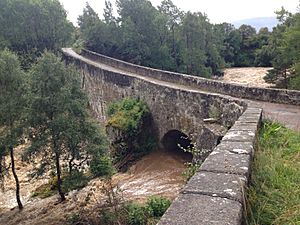
The road went northwest over the 2114-foot Lecht pass. The modern A939 road largely follows this path to Tomintoul. From Tomintoul, the road was built west to Grantown-on-Spey. This involved building bridges over two big rivers: Bridge of Avon and Bridge of Brown.
Beyond Grantown-on-Spey, the road went north and west. It crossed the powerful River Findhorn at Dulsie Bridge. It continued northwest to cross the River Nairn west of Cawdor. Only short parts of this are used as modern roads. The final section went straight. The modern B9090 and B9006 roads follow it to Ardersier and Fort George.
Roads in Northeast Scotland
Roads in Aberdeenshire and Banffshire existed long before the military. But from about 1752, Caulfeild's troops helped improve about 250 miles of road. This was partly paid for by the military. A main route went from Fettercairn over Cairn o' Mount. It passed through Alford, Keith, and Huntly to Fochabers. The military improved and kept up this road from about 1761 to 1784. But at Potarch, people always had to cross the River Dee by ferry.
Other routes went from Stonehaven through Aberdeen and Kintore to Fochabers and Portsoy. There was also a road from Portsoy to Huntly. And one from Corgarff Castle to Aberdeen along the River Don. Parts of the road along the River Dee were also maintained.
Bridge of Sark to Portpatrick Road
Caulfeild also built a military road from Bridge of Sark. This was near Gretna, Dumfries and Galloway. It went west to Port Patrick on the east coast of the North Channel in Galloway. The road passed through or near Dumfries, Haugh of Urr, Castle Douglas, Bridge of Dee, Gatehouse of Fleet, Creetown, Newton Stewart, Glenluce, and Stranraer.
It was built in the 1760s to help move troops to Ireland. It used parts of existing roads. Much of its 105 miles is now under the modern A75 road. Other parts are now minor roads or tracks. Some sections are completely gone.
What Happened Next
The building of highland roads stopped when Caulfeild died in 1767. About 1100 miles had been built. Wade built 300 miles, and Caulfeild built the remaining 800 miles.
As the Jacobite threat faded in the late 1700s, the military no longer needed to keep the roads in good shape. Some parts were completely abandoned if they were not useful for trade. Travelers avoided the steeper parts, which were not good for coaches. By 1790, only 600 miles were still usable.
In 1803, the Commissioners of Highland Roads and Bridges were created. They took over keeping the roads in repair after the military stopped.
The military road between Grantown and Fort George was not maintained by these commissioners. Instead, different landowners and authorities patched it up. When original bridges on this route were washed away by floods, new ones were built.
The civilian road network got better in the 1800s. Thomas Telford and others improved it. Many parts of Wade’s and Caulfeild’s roads were used in this new network. But many other sections were not needed by the general public and fell out of use. Miles of old road can still be seen today. They are either completely abandoned or used as paths for walking and mountain biking.
Recently, some parts have become sections of long-distance paths like the West Highland Way. Others are now part of the growing National Cycle Network. Several sections of the military roads are protected as scheduled monuments. This includes parts of the Corrieyairack Pass and the Fort Augustus to Bernera road.
The Dunkeld to Inverness road gives its name to Neil Munro's novel The New Road.


